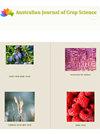Recovery of three different varieties of tobacco (Nicotiana tabacum L.) under waterlogging stress
Q3 Agricultural and Biological Sciences
引用次数: 1
Abstract
Tobacco plant is one of the high commercial crops that give the largest foreign exchange sources in Indonesia. It also contributes to providing employment not only for farmers but also industrial sectors. Tobacco plant experiences growth failure due to excessive rain, which causes waterlogging to the plants so that the plants become submerged and show hypoxia. A hypoxia tolerant variety is needed to reduce losses in tobacco cultivation. The research was conducted in a greenhouse and biology laboratory at the University of PGRI Argopuro Jember. This research aimed to study the post-hypoxic stress recovery ability in three previously studied varieties of tobacco plants such as sensitive, moderate, and tolerant varieties. The results showed that the treatment of hypoxic stress on tobacco plants significantly affected the parameters of stomatal activity, transpiration rate, and the amount of reducing sugar. In the sensitive and moderate tobacco varieties, the greater percentage of waterlogging resulted in decreased stomatal activity, transpiration rate, and percentage of sucrose. The tolerant tobacco varieties (Bojonegoro var.) show a tendency to increase stomatal activity (76.203, 79.735, 86.963, and 92.227, respectively, for waterlogging 100%, 120%, 140%, and 160% field capacity), transpiration rate (0.139, 0.124, 0.130, and 0.146, respectively, for waterlogging 100%, 120%, 140%, and 160% field capacity), and percentage of sucrose (3.45, 3.64, 3.73, and 4.31, respectively, for waterlogging 100%, 120%, 140%, and 160% field capacity) with a higher percentage of waterlogging. Three varieties of tobacco with tolerant, moderate, and sensitive categories to hypoxia developed different metabolisms to cope with energy crises caused by waterlogging stress comprised of the stomatal conductance, transpiration rate, and sucrose percentage涝渍胁迫下三种不同烟草品种的恢复
烟草是印尼最大的外汇来源的高经济作物之一。它还有助于为农民和工业部门提供就业机会。烟草植株因雨水过多而生长衰竭,造成植株内涝,使植株淹水缺氧。为了减少烟草种植的损失,需要一个耐缺氧的品种。这项研究是在PGRI大学的温室和生物实验室进行的。本研究旨在研究已研究过的3个烟草品种(敏感型、中等型和耐氧型)在缺氧胁迫后的恢复能力。结果表明,低氧胁迫处理对烟草植株气孔活性、蒸腾速率和还原糖量等参数有显著影响。在敏感型和中度型烟草品种中,涝渍率越高,气孔活性、蒸腾速率和蔗糖含量越低。耐涝品种(Bojonegoro var.)在涝渍100%、120%、140%和160%条件下气孔活性(76.203、79.735、86.963和92.227)、蒸腾速率(涝渍100%、120%、140%和160%条件下分别为0.139、0.124、0.130和0.146)和蔗糖含量(涝渍100%、120%、140%条件下分别为3.45、3.64、3.73和4.31)均有增加的趋势。和160%的现场容量),涝渍率较高。3个耐、中、敏感低氧烟草品种在应对涝渍胁迫能量危机时,气孔导度、蒸腾速率、蔗糖率等代谢指标存在差异
本文章由计算机程序翻译,如有差异,请以英文原文为准。
求助全文
约1分钟内获得全文
求助全文
来源期刊

Australian Journal of Crop Science
农林科学-农艺学
CiteScore
1.20
自引率
0.00%
发文量
75
审稿时长
3.5 months
期刊介绍:
Information not localized
 求助内容:
求助内容: 应助结果提醒方式:
应助结果提醒方式:


